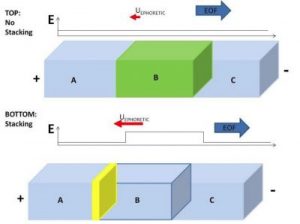FASS for Sample Concentration in a Nanochannel
Field Amplified Sample Stacking (FASS) for Sample Concentration in a NanochannelElizaveta Davies et al July 4, 2012
A ubiquitous problem in analytical chemistry is the push to increase signal-to-noise (S/N) and to lower the limits of detection (LOD) for many sample separation methods. Low S/N is typically due to the inherent low concentration of the sample in the system and the band-broadening of the sample in dead volumes of the analytical system. The microfluidic chip platform can address both these issues. Microfluidic channel networks have an advantage over conventional fluidics for chemical separations by eliminating dead volume found in tubing-based connections. This can be exploited when using electric field manipulation for increasing the concentration of sample in the injected volume. Field Amplified Sample Stacking (FASS) takes advantage of the effect of applying an electric field across a conductivity gradient in the buffer. The amplification gained by FASS is even more efficient when coupled with a microfluidic chip, due to channel integration that minimizes dead volumes. In this application note, we will describe the procedure for FASS using commerical LabSmith equipment.
Application: Lab-on-a-Chip

